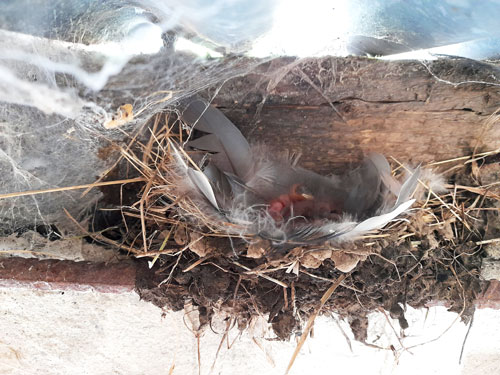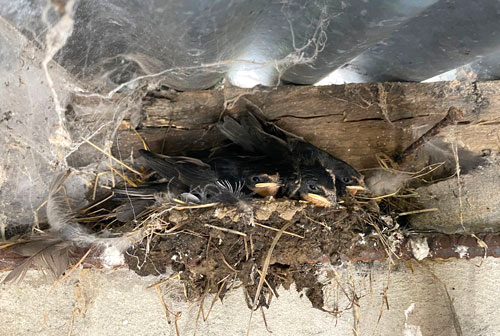
We wrote about a second clutch of 4 swallows being reared by “Barney” and “Beakey” some 15 days ago, soon after all their eggs hatched, on August 14th, 2021. Now 14 days later, look how they have grown, filling their second mud nest, on a diet of Thurles insects.

Swallows have been around on our planet for a very, very long time. A remark found in Aristotle’s (384BC–322BC) best-known work on ethics “Nicomachean Ethics” reads “one swallow does not a summer make”.
The play “Timon of Athens”, latter a sharp satire on wealth, greed and betrayal and written by William Shakespeare between 1605 and 1606, contains the phrase, “The swallow follows not summer more willing than we your lordship”.
On coming here to Thurles the swallow, in many cases, travels well over 6,500 miles from sub-Saharan Africa to spend the summer with us. They come to take advantage of our longer hours of daylight; our abundant sources of flying insects and the lack of other competition to their ‘on the wing’ food source. Were they to remain in their African winter-quarters, swallows would have to share their airspace with at least a dozen other related flying species.
Thus this small bird, that weighs less than an ounce (20 grams) is prepared to fly north-westwards, at great personal risk, to take advantage of our more temperate latitude, a classification we share with most of north-west Europe.
Swallows navigate using the Earth’s magnetic field; polarised light and visual landmarks, which incredibly allow them to return to the very same area here in Tipperary, where they were originally born.
Soon around mid-September of the current year, their return journey will take them back, south-eastwards, across the North Atlantic sea.
Since swallows feed entirely on flying insects, they don’t need to fatten up before departing, rather they will grab their food, on the wing, along their chosen flightpath; over their six week journey, covering up to 200 miles each day. They will, using day light, cross western Europe; breaking their journey, to drink or feed as they feel the need. They will congregate on headlands before taking flight to cross the Mediterranean Sea; then across the Sahara Desert; the jungles of equatorial Africa, until Table Mountain comes into their vision; thus signalling to each that they have at last reached the approximate vicinity of their wintering quarters.
Meanwhile, we here in Ireland are left bereft until next April. Watch them, enjoy them, while they are still around to be observed, in the knowledge and firm belief that “men may make plans, but God laughs”.

Leave a Reply